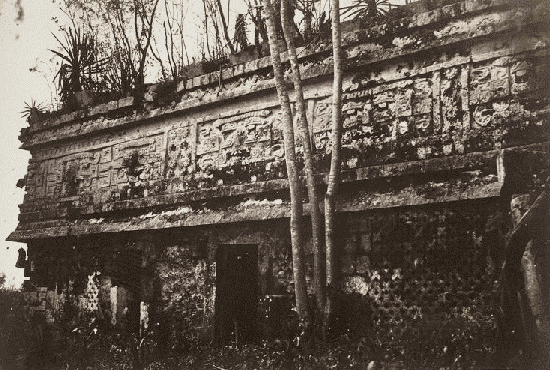Mayan Ruins in the Yucatan at Chichen Itza
The prehistoric structures of Yucatan—among the principal of which are those of Uxmal and Chichen-Itza—are exceedingly numerous. Indeed, the traveller in this territory of the Mayas is rarely out of sight of crumbling pyramid or temple, as he traverses the dense forests of these curious flat and streamless limestone regions. Whilst most of these edifices were for purposes of religious ceremonial, the object of many of them can scarcely be conjectured. Their builders appear to have been people of a peaceful nature, and their dwellings do not generally bear evidence of defensive design. The architectural skill of the Mayas must have been of a very high order. Among the buildings which exist some are nearly perfect units of design, and seem almost to argue the use of "working drawings," as the plan and detail must have been perfected as a whole before the building was begun. This architectural skill of conception, however, has been common in many countries. Some of the buildings were in use when Cortes landed and fought on the shores of Yucatan, nearly four hundred years ago; nevertheless, they are in a remarkable state of preservation, notwithstanding the ravages both of Nature and of man, tending towards their destruction; for on the one hand, the roots of trees and profuse vegetation of a tropical region are efficient levers in the throwing down of the masonry, and on the other, the vandal ignorance of the surrounding inhabitants of the modern towns of the region permits them to make use of the stones in their own walls.
The ruins of Chichen-Ytza, the prehistoric city in the northern part of Yucatan, are among the most important and best preserved of any of the stone structures of the Americas. The ruins are grouped around two great natural wells, the cenotes, famous in this remarkable peninsula. Indeed, the derivation of the name of the old city is from Maya words meaning the "Mouth of the Well," and it serves to show the value in which these singular water-supplies were held in this riverless region of Yucatan. Among the most interesting of the structures of Chichen and Uxmal is that of the buildings known as El Foloc, or "the Church." Another is that known as the "House of the Nuns," and yet another the "Temple of the Tigers," which latter shows a sculptured procession of tigers or lynxes. Again, "the Castle" is remarkable, set upon a pyramid rising more than 100 feet above the plain. The "Governor's Palace," the "House of the Pigeons," and "House of the Turtles," are others of these remarkable structures.
The profuse and extraordinary, yet barbaric-appearing sculpture of the façades and interiors of these buildings arrests the observer's attention, and, indeed, fills him with amazement, as does their construction in general. What instruments of precision did a rude people possess who could raise such walls, angles, monoliths, true and plumb as the work of the mason of to-day?
It would be beyond the scope of this work to enter more fully into the details of these ruins. They have been minutely examined and described by famous archæologists, who have devoted much time thereto, and the student may be referred to their works. The foregoing is but a sketch, barely touching upon the extensive and beautiful handwork in stone of the ancient dwellers of this land. Indeed, the traveller may behold them for himself, without great risk or difficulty. He will observe them with admiration. Pyramids rising from the plains or forest-seas which surround them; strange halls where unknown people dwelt; great cities where busy races lived. The character of the various groups of ruins throughout the land shows the effect that the geology of the respective regions has had upon the stone-masonry of these prehistoric builders. As has been shown, the beautiful trachyte of Mitla, which, whilst it is tough and enduring, is soft, and lends itself readily to the chisel. The result has been handed down in the beautiful and exact sculpture of the blocks and grecques of the façades of these palaces: work which could not have been performed in a more refractory stone. Not a great distance away are the Monte Alban ruins, as described, which, although extensive and remarkable, show nothing of exact and intricate work in stone-shaping. The hard or silicious rocks which form the immediate region, and the quartzite and crystalline limestone, did not lend themselves, either in the quarry or under the chisel, to such work. In Chiapas, the unshaped and uncoursed masonry of Palenque is formed of a hard, brittle limestone, scarcely capable of being worked to faces. No invisible joints, such as are the beauty of some of the ancient stone structures of the Americas—North and South—were possible, and mortar and stucco were freely employed. Very different, however, was the limestone used in Yucatan. It was easily quarried from its bed, and was of such a texture as lent itself to the profuse and beautiful sculpture of those Maya cities of long ago. Again, the great pyramidal structures of Teotihuacan and surrounding ruins of the Toltec civilisation, had little for their composition but lavas of basaltic nature, which did not possess a character adaptable for exact stone-shaping. Thus it is seen how largely the existence, or non-existence, of freestone influenced the character of these prehistoric structures.




